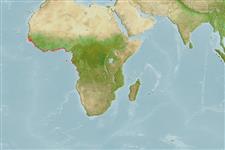Teleostei (teleosts) >
Beloniformes (Needle fishes) >
Belonidae (Needlefishes)
Etymology: Strongylura: Greek, strongylos = round + Greek, oura = tail (Ref. 45335).
More on author: Valenciennes.
Environment: milieu / climate zone / depth range / distribution range
Ecology
Marine; brackish; pelagic-neritic; depth range 0 - ? m. Tropical; 14°N - 17°S
Eastern Atlantic: Senegal and Guinea south through the Gulf of Guinea to Angola (Ref. 5757). Reported from Gambia River (Ref. 28587).
Size / Weight / Age
Maturity: Lm ? range ? - ? cm
Max length : 150 cm SL male/unsexed; (Ref. 2683); common length : 60.0 cm SL male/unsexed; (Ref. 2683)
Dorsal spines (total): 0; Dorsal soft rays (total): 13 - 16; Anal spines: 0; Anal soft rays: 14 - 18. Diagnosis: body elongate; upper and lower jaws extremely long, forming a stout beak armed with strong teeth; nostrils in depression before eyes (nasal pit); gill rakers absent; pelvic fins abdominal; 13-16 dorsal-fin rays; no lateral keel on caudal peduncle; caudal fin emarginated (Ref. 57228).
Found in coastal areas, entering estuaries and brackish lagoons (Ref. 5757). Feeds mainly on small fishes (Ref. 28587). Oviparous (Ref. 205); eggs may be found attached to objects in the water by tendrils on the egg's surface (Ref. 205).
Life cycle and mating behavior
Maturities | Reproduction | Spawnings | Egg(s) | Fecundities | Larvae
Collette, B.B. and N.V. Parin, 1990. Belonidae. p. 592-597. In J.C. Quero, J.C. Hureau, C. Karrer, A. Post and L. Saldanha (eds.) Check-list of the fishes of the eastern tropical Atlantic (CLOFETA). JNICT, Lisbon; SEI, Paris; and UNESCO, Paris. Vol. 2. (Ref. 5757)
IUCN Red List Status (Ref. 130435)
Threat to humans
Harmless
Human uses
Fisheries: minor commercial
Tools
Special reports
Download XML
Internet sources
Estimates based on models
Preferred temperature (Ref.
123201): 25.4 - 28, mean 27.4 °C (based on 185 cells).
Phylogenetic diversity index (Ref.
82804): PD
50 = 0.5001 [Uniqueness, from 0.5 = low to 2.0 = high].
Bayesian length-weight: a=0.00076 (0.00040 - 0.00144), b=3.13 (2.97 - 3.29), in cm total length, based on LWR estimates for this species & Genus-body shape (Ref.
93245).
Trophic level (Ref.
69278): 4.5 ±0.80 se; based on food items.
Resilience (Ref.
120179): Medium, minimum population doubling time 1.4 - 4.4 years (Preliminary K or Fecundity.).
Fishing Vulnerability (Ref.
59153): Very high vulnerability (90 of 100).
Nutrients (Ref.
124155): Calcium = 100 [34, 375] mg/100g; Iron = 0.889 [0.434, 2.134] mg/100g; Protein = 17.1 [15.2, 19.0] %; Omega3 = 0.208 [0.083, 0.596] g/100g; Selenium = 47.7 [21.4, 104.7] μg/100g; VitaminA = 30.9 [9.7, 112.4] μg/100g; Zinc = 0.896 [0.596, 1.385] mg/100g (wet weight);
